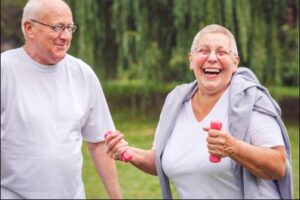Beyond Concussion: I Keep Falling. Why?
“I’m 75 and trying to stay active. I keep falling and no one can figure out why. I don’t want to use this walker but I’m afraid to be moving around without it.”
Falling, a post-concussion issue?
Head injuries don’t just happen to children and athletes. Falls amongst older adults are a leading cause of head injuries. (Statistics are below.)
Older adults who might be your parents, grandparents, aunts, uncles, friends, and neighbors are important people. You enjoy doing things together! But when they fall you wonder, will they be able to recover their active lifestyle?
Falls, with or without injury, carry a heavy quality of life impact. A growing number of older adults fear falling and, as a result, limit their activities and social engagements. This can result in further physical decline, depression, social isolation, and feelings of helplessness.
National Council on Aging
It doesn’t have to be this way. Read about a client who fell and found herself caught in the downward spiral.
 The case of the recurrent falls
The case of the recurrent falls
Our client, age 75, comes in periodically for help with movement and pain related to a severe auto accident 15 years ago. She was a very active person before the auto accident, and still tries to be as active as possible.
What exactly occurred?
Earlier this summer she tripped and landed hard on her knee. In addition to the knee her mobility took a hit and she had to use a walker to safely get around. She follows up with us every 4-6 weeks and each time there were more falls. Frustrating for her and confounding for us.
We stepped back to ask, “why are you falling, and always to your right side?” The loss of stability and confidence all began with the summer trip and fall. “Is there a chance your head hit something when you fell?” we asked.
Talking through the details she realized she had hit her head. The hip and knee were hurt so bad that they took the attention away from her head.
Which of her foundational movements were impacted?
We had to figure how the fall disturbed her movement foundation. In our assessment we quickly found the coordination of her leg and core were not working correctly. The fall also threw off the symmetry of her core movements. We used the Bridging movements to link her leg and core back together and re-center her core movements.
Were there Sensory System Integration Issues?
Yes! The loss of balance control to her right side was a factor in the subsequent falls. We tested her balance reactions in multiple directions. This revealed that her sway control (the ability to keep oneself safe when off balance) had gone awry, but only to the right. The poor balance control was not keeping her safe.
Did prior injuries play a role?
Yes — the prior auto accident left symmetry permanently affected. Because we had worked together we were tuned into her normal asymmetries. We also knew her balance was reasonably good for her activity level.
How correct were the head/body relationships to begin with?
Another complicating factor, she was born with malformed hips and had them replaced years ago. The leg-core relationships are not quite right because of this. Even so, her balance before the fall was reasonably good.
The wrap-up
Once figuring out there was a head injury impacting balance (vestibular system) we used the gentle Bridging technique movements to support her body and head, allowing the vestibular reactions to regroup. She left the office moving steady and not feeling the need for her walker. A few weeks later and the walker is now relegated to the closet.
One in four Americans aged 65+ falls each year.
- Falls are the leading cause of fatal injury and the most common cause of non-fatal trauma-related hospital admissions among older adults.
- Falls result in more than 2.8 million injuries treated in emergency departments annually, including over 800,000 hospitalizations and more than 27,000 deaths.
According to the U.S. Centers for Disease Control and Prevention
At Kinetic Konnections we look at different aspects of an injury.
We take your entire history into account, looking at how your head, core, and limbs currently work together compared to how they are naturally supposed to work together.
Some of the unique information we gather and use in our problem-solving includes:
- What exactly occurred in the injury event? (and what else occurred that you don’t recall based on the logistics of the event.)
- Which of the fundamental head and body movement relationships were impacted?
- How was the integration of key sensory systems affected? (Vision and vestibular/balance)
- What prior injuries also impacted the foundational head and core movement relationships?
- Were the head/body relationships compromised from early developmental factors?
While these questions may seem unrelated, the answers are important. Answers to these questions lead us to the missing piece of your puzzle to get you back on your way to moving well.
A unique five-step process to get you back to better function
Our first step is gather injury information and assess key aspects of stability, balance, symmetry, and visual-motor function.
Step two is to re-center the movements of the body and of the head, and link the arms and legs. We use the gentle Bridging technique movements to do this, and often begin from a position of reconstructing the event. Essentially, we back-up the body’s structural relationships to the point before they got off track and help erase the way the forces and torques changed them.
Step three is to refresh all the correct relationships so the body remembers how it is structurally supposed to work. Restoring muscle memory is one way to think of this.
Step four is to refine the relationships of the body, head, eyes and balance system. Sometimes this falls into place just by centering the head and body.
Step five, when needed, is a more complex step to account for skewed movements from early years of development, and/or prior injuries. This is a critical step that we uniquely consider at Kinetic Konnections and it makes a difference!
Sharing resources
- In our FB videos I share a more detailed explanation of how we resolve head injury issues using the Bridging technique. (You do not need a FB account to watch.)
- Information about falls and prevention strategies for older adults. Read here.
- Adults over 65 TBI statistics from the CDC. Read here.
During October, I am focused on different scenarios of head injury and how the Kinetic Konnections’ unique perspective addresses overlooked aspects which are essential to recovery.
The four head injury scenarios discussed this month:

